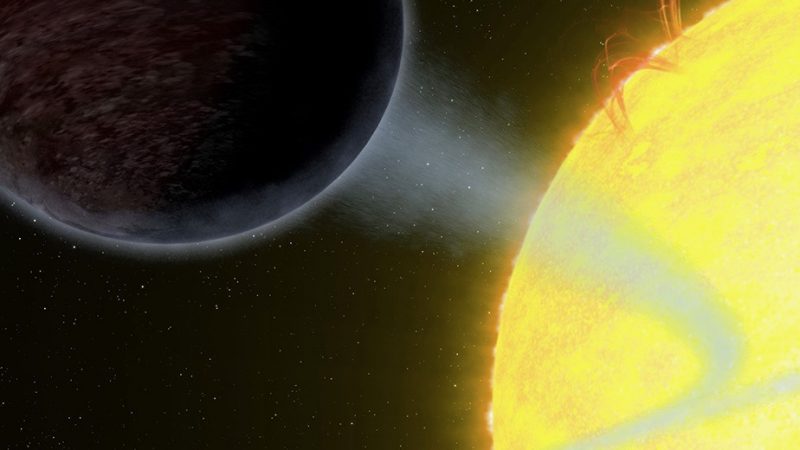
The Hubble Space Telescope has observed an exoplanet – or planet orbiting a distant star – that looks as black as fresh asphalt. The planet is called WASP-12b, and it’s one of a class of so-called hot Jupiters, gigantic, gaseous planets orbiting close to their host stars and thereby heated to extreme temperatures. The astronomers say this planet is so black because it absorbs some 94 percent of the visible starlight falling into its atmosphere, rather than reflecting it back into space. Their work was published online on September 14, 2017 by the peer-reviewed journal Astrophysical Journal Letters. A statement from HubbleSite said:
The planet’s atmosphere is so hot that most molecules are unable to survive on the blistering day side of the planet, where the temperature is 4,600 degrees Fahrenheit. Therefore, clouds probably cannot form to reflect light back into space. Instead, incoming light penetrates deep into the planet’s atmosphere where it is absorbed by hydrogen atoms and converted to heat energy.
This planet is about 1,400 light-years away. It orbits a sunlike star, located in our sky in the direction of the constellation Auriga the Charioteer. Astronomer Taylor Bell of McGill University and the Institute for Research on Exoplanets in Montreal, Quebec, Canada, is lead researcher of the Hubble study. He said:
We did not expect to find such a dark exoplanet. Most hot Jupiters reflect about 40 percent of starlight.
WASP-12b is about 2 million miles (3 million km) from its star. It has a fixed day side and night side; that is, it orbits so near its star that it’s tidally locked to the star, much as our moon is tidally locked to Earth and thus keeps a single face turned perpetually toward our planet. The night side of WASP-12b is more than 2,000 degrees Fahrenheit cooler than the day side. Water vapor exists in the atmosphere on the night side, and clouds do form. Previous Hubble observations of the day/night boundary detected evidence of water vapor and possibly clouds and hazes in the atmosphere. Bell said:
This new Hubble research further demonstrates the vast diversity among the strange population of hot Jupiters. You can have planets like WASP-12b that are 4,600 degrees Fahrenheit and some that are 2,200 degrees Fahrenheit, and they’re both called hot Jupiters. Past observations of hot Jupiters indicate that the temperature difference between the day and night sides of the planet increases with hotter day sides. This previous research suggests that more heat is being pumped into the day side of the planet, but the processes, such as winds, that carry the heat to the night side of the planet don’t keep up the pace.
These astronomers used the Hubble’s Space Telescope Imaging Spectrograph to search in mostly visible light for a tiny dip in starlight as the planet passed directly behind the star. The amount of dimming tells astronomers how much reflected light is given off by the planet. However, the observations did not detect reflected light, meaning that the daytime side of the planet is absorbing almost all the starlight falling onto it.
Bottom line: Astronomers used the Hubble Space Telescope to study the exoplanet WASP-12b and found that is absorbs most starlight falling onto it, so that it is “as black as fresh asphalt.”











